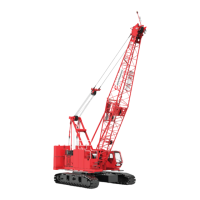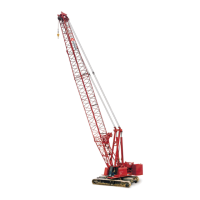Manitowoc Published 05-26-17, Control # 238-02 5-47
MLC165-1 SERVICE/MAINTENANCE MANUAL HOISTS
• A weight (5 or 8) freely suspended by a chain (4) from
each limit switch actuating lever (weight encircles load
line as shown).
• A lift plate (6) fastened to the load line, or
A lift block (9) fastened to the load block.
For service of the block-up limit components in the luffing jib,
see the MLC165 Luffing Jib Operator Manual supplied with
the luffing jib.
Theory of Operation
See Figure 5-32 and Figure 5-33 for component
identification.
For a complete wiring diagram of the system, see the Boom
Wiring and Limits Drawing.
Normal conditions (Block-Up Limit Control
Deactivated)—During normal operation, the weight
overcomes spring force and rotates the actuating lever away
from the limit switch lever. This allows the limit switch to
close the hoist control handle electric circuits.
Block-Up Limit Control Activated—When the weight is
lifted by the lift block or the lift plates, spring force rotates the
actuating lever against the limit switch lever. This causes the
corresponding limit switch to open the hoist control handle
electric circuits.
Then the load drum and the boom/mast hoist pumps stroke
to off. At the same time, the load drum and the boom hoist
parking brakes apply to stop the load drum from hoisting and
the boom from lowering.
Weekly Maintenance
See Figure 5-32 for the following procedure.
Inspect and test the block-up limits weekly or every 40
hours of operation, as follows:
1. Lower the boom (and the jib, if equipped) onto blocking
at ground level.
2. Carefully inspect the following items:
a. Inspect each weight (5 and 8) for freedom of
movement on the load line.
b. Inspect each weight, chain, shackle and connecting
pin (11) for excessive or abnormal wear. Make sure
the cotter pins for the shackles are installed and
spread.
c. Inspect the entire length of each electric cable for
damage.
d. Check that the electric cables are clear of all moving
parts on the boom (and the jib, if equipped).
e. Make sure that the cables are securely fastened to
the boom (and the jib, if equipped) with nylon straps.
f. Check that all electric cable connections are
securely fastened.
3. Test the block-up limit devices for proper operation
using either of the two following methods:
- Boom Lowered Method—
While the boom is lowered and with the engine
running:
Manually lift one of the weights. Try to operate the
drums. The corresponding load drum should not
operate in the up direction and the boom hoist drum
should not operate in the down direction.
Test each block-up limit device this way.
- Boom Raised Method—
Slowly hoist one of the load blocks and the weight
ball against the weight. When the chain goes slack,
the corresponding load drum should stop and the
boom hoist should not operate in the down direction.
Test each block-up limit device this way.
CAUTION
Avoid Machinery Damage
If inspection reveals a problem with the block-up limit
components, do not operate the crane until the block-up
limit has been repaired to proper working order.
CAUTION
Avoid Sheave Damage
Use extreme care when testing the block-up limits when
the boom is raised. If a block-up limit fails to stop the load,
immediately stop the hoist.
CAUTION
Avoid Sheave Damage
Do not lengthen or shorten the chains that hold the block
limit weights. Proper chain length and weight is necessary
for proper switch activation.
If replacement is needed, replace with the same length,
size, and material specified in the Parts Manual.
